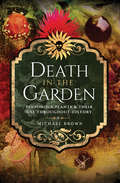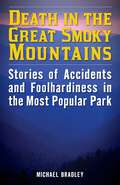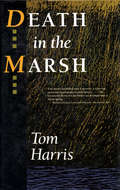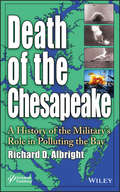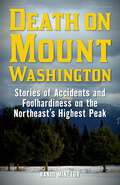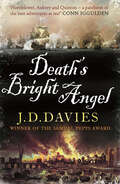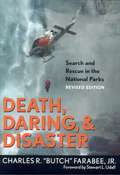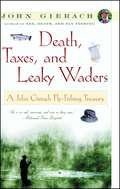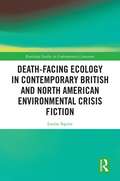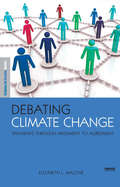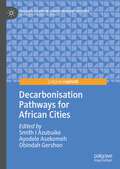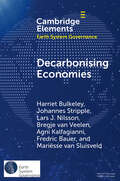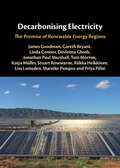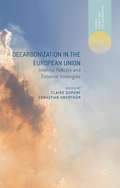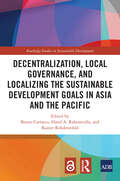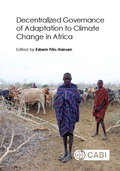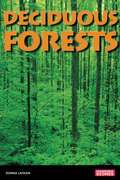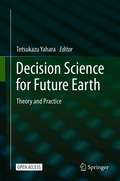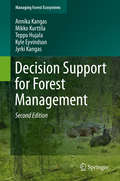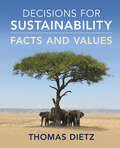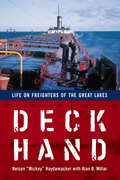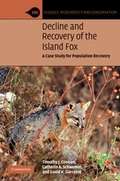- Table View
- List View
Death in the Garden: Poisonous Plants & Their Use Throughout History
by Michael Brown&“Readers who enjoy plants and offbeat tales will find Brown&’s book a happy mix&” (Publishers Weekly). Mankind has always had a morbid fascination with poisonous plants. Over the centuries, poisonous plants have been used to remove garden pests—as well as unwanted rivals and deceitful partners. They have also been used for their medicinal qualities, as rather dangerous cosmetics, and even to help seduce a lover when perceived as an aphrodisiac. Some of these and other uses originate in a medieval book that has not yet been translated into English. This book delves into the history of these plants, covering such topics as: How shamans and priests used these plants for their magical attributes, as a means to foretell the future or to commune with the godsHow a pot of basil helped to conceal a savage murderThe truth about the mysterious mandrakeA conundrum written by Jane Austen to entertain her family—the answer to which is one of the plants in this book These stories and many more will enlighten you on these treacherous and peculiar plants, their defensive and deadly traits, the facts behind them, and the folklore that has grown around them.
Death in the Great Smoky Mountains: Stories of Accidents and Foolhardiness in the Most Popular Park (Death in the National Parks)
by Michael R. BradleyIt's no surprise that fatalities occur every year in Great Smoky Mountains National Park due to the sheer number of visitors--more than ten million annually! In these cautionary tales, Bradley recounts deaths and other unfortunate incidents that have resulted from accidents and human folly, including bear attacks, swift water disasters, and mysterious disappearances. Armchair travelers and park visitors alike will be fascinated by the dangers lurking in America's most visited national park and will be better informed about what to do and what not to do the next time they enter its gates.
Death in the Marsh
by Tom HarrisSelenium, essential in microscopic doses, can be deadly in larger amounts. Death in the Marsh explains how federal irrigation projects have altered selenium's circulation in the environment, allowing it to accumulate in marshes, killing ecosystems and wildlife, and causing deformities in some animals.
Death of the Chesapeake: A History of the Military's Role in Polluting the Bay
by Richard AlbrightIn essence this book deals with an area that contributes significantly to the pollution and degradation of Chesapeake Bay, but has been completely overlooked in many of the efforts to restore the Bay, specifically, the federal military pollution sources. The book also recognizes for the first time, that efforts to restore the Bay have failed because of violation of a fundamental precept of environmental cleanup; that is, to sample the site and see what is there. The Bay itself has never been sampled. Thus this book presents a view of the environmental condition of Chesapeake Bay that is totally unique. It covers a part of the history of the Bay that is not widely known, including how the Bay was formed. It presents a mixture of science, military history, and novel solutions to the Bay's degradation. In so doing, the author examines the military use of the Bay and reveals the extent of munitions dumpsites containing nitrogen and phosphorus as well as chemical warfare material, and how this is effecting the environment. The book concludes with the author's own clean-up plan that, if implemented, would go a long way to restoring health to Bay. The book is supplemented with many photographs and maps.
Death on Mount Washington: Stories of Accidents and Foolhardiness on the Northeast's Highest Peak (Non-Fiction)
by Randi MinetorOn Mount Washington, it&’s lack of preparation, not the mountain, that kills. The weather is highly changeable with wind gusts of 140 mph and -35 degree temps. Then there are the avalanches and icefalls. Combine this with inexperienced hikers in t-shirts and flip flops and things can get ugly fast.Death on Mount Washington describes the circumstances behind the tragic tales of those who have lost their lives on the mountain. No one--not even the most experienced mountaineer or pilot--is safe from the mountain's mercurial weather conditions. Learn from the mistakes of others in the comfort and safety of your armchair and remember to respect Mount Washington on your next ski trip.
Death's Bright Angel (The Matthew Quinton Journals)
by J. D. DaviesPart of an &“excellent series,&” this seafaring adventure features a Royal Navy captain as he battles terrorism in seventeenth-century England (Publishers Weekly). London is burning, but who set the fire? In the weeks leading up to the Great Fire of 1666, Matthew Quinton, master of the H. M. S. Sceptre, is sent into the heart of London, seething with foreign plots and political paranoia, on a dangerous mission: to keep a terrorist ring from destroying the capital. Quinton is the only man that can stop these men, who want to open the country to invasion by destabilizing the English people and fueling rebellion. But unrest may not be the only thing these men will fuel . . . The heat is rising. With fast-paced action and fantastic historical detail, Death&’s Bright Angel is the seventh thrilling book in the Matthew Quinton series of nautical sagas. Praise for the writing of J. D. Davies: &“Hornblower, Aubrey and Quinton—a pantheon of the best adventures at sea!&” —Conn Iggulden, #1 New York Times–bestselling author of The Conqueror and War of the Roses series &“A hero worth rooting for.&” —Publishers Weekly &“Utterly impossible to put down . . . Finely-shaded characters, excellent plotting, gut-clenching action and immaculate attention to period detail . . . Superb.&” —Angus Donald, author of The Outlaw Chronicles series &“Destined to be a classic of nautical adventure series.&” —Eric Jay Dolin, author of Leviathan and Fur, Fortune, and Empire &“A naval adventure that goes well beyond the usual outlines of the genre to paint a lively portrait of England in the 1600s.&” —Kirkus Reviews
Death, Daring, and Disaster: Search and Rescue in the National Parks
by Charles R. Farabee Jr.375 exciting tales of heroism and tragedy drawn from the nearly 150,000 search and rescue missions carried out by the National Park Service since 1872.
Death, Taxes, and Leaky Waders
by John GierachDeath, Taxes, and Leaky Waders collects forty of John Gierach's finest essays on fishing from six of his books. Like all his writing, these essays are seasoned by a keen sense of observation and a deep knowledge and love of fishing lore, leavened by a wonderfully wry sense of humor. This is the first anthology of Gierach's work, a collection that is sure to delight both die-hard fans and new readers alike.
Death-Facing Ecology in Contemporary British and North American Environmental Crisis Fiction: Ecological Death-facing in Contemporary British and North American Fiction (Routledge Studies in Contemporary Literature)
by Louise SquireRecent years have seen a burgeoning of novels that respond to the environmental issues we currently face. Among these, Louise Squire defines environmental crisis fiction as concerned with a range of environmental issues and with the human subject as a catalyst for these issues. She argues that this fiction is characterized by a thematic use of "death," through which it explores a "crisis" of both environment and self. Squire refers to this emergent thematic device as "death-facing ecology". This device enables this fiction to engage with a range of theoretical ideas and with popular notions of death and the human condition as cultural phenomena of the modern West. In doing so, this fiction invites its readers to consider how humanity might begin to respond to the crisis.
Debating Climate Change: Pathways through Argument to Agreement (The\earthscan Science In Society Ser.)
by Elizabeth L MaloneAs greenhouse gas emissions continue unabated and contentious voices fill the air, the question gains urgency: How can people with widely varying viewpoints agree to address climate change? Each participant in the debate seems to have a different agenda, from protecting economic growth in developing countries to protecting the energy industry in industrialized countries, from those aghast at the damage done to the Earth to optimists who think we just need to adjust our technological approach. Debating Climate Change sorts through the tangle of arguments surrounding climate change to find paths to unexpected sites of agreement. Using an innovative sociological approach - combined discourse and social network analyses - Elizabeth L. Malone analyzes 100 documents representing a range of players in this high-stakes debate. Through this she shows how even the most implacable adversaries can find common ground - and how this common ground can be used to build agreement. Written in a clear, accessible style, this original research and insightful use of communication analysis will help advance understanding and negotiation on climate change throughout the pivotal times to come. Published with Science in Society
Debating Climate Law
by Alexander Zahar Benoit MayerWhat role could or should the law play in dealing with the climate emergency? In this innovative volume, leading scholars explore fundamental debates at the frontier of climate change law scholarship. They address the key areas of scholarly disagreement about what climate change law is, the legal rules it consists of, and how these rules could be implemented in the real world. The first eleven topics are debated by teams of scholars expressing diametrically opposite points of view on each topic, in traditional debating style; the last seven chapters are presented as an individual author's own reflection on a topic that cannot readily be reduced to a binary debate. Each chapter is written in an accessible and thought-provoking way, emphasizing clear lines of argumentation. The debating-style format is designed to stimulate students to think critically and logically about the law and to fire up debate in and out of class.
Decarbonisation Pathways for African Cities (Palgrave Studies in Climate Resilient Societies)
by Smith I Azubuike Ayodele Asekomeh Obindah GershonThis book examines the pathways to decarbonising African cities, structured around strategies and applications in renewable energy, waste management, healthcare, telecommunication, education and governance reconfigurations for Petro-cities. Throughout the book the authors highlight infrastructural, governance and policy approaches to drive decarbonisation. Opening with chapters focused on propositions for solar urban planning and scope for decarbonisation in waste management the book then moves on to examine innovative strategies for a low-carbon healthcare sector. The authors then discuss the use of hybrid power systems at remote telecommunication sites, their deployment on university campuses, and how this can be optimised to reduce carbon emissions. Further chapters explore government, private sector and civil society actions for decarbonising Kenyan cities and an overview of the political economic choices for decarbonising Petro-cities. Finally, closing chapters propose mechanisms for translating COP26 takeaways to decarbonisation policies and a low-carbon framework for African cities.
Decarbonising Economies (Elements in Earth System Governance)
by Johannes Stripple Harriet Bulkeley Agni Kalfagianni Lars J. Nilsson Bregje van Veelen Fredric Bauer Mariësse van SluisveldBased on an interdisciplinary investigation of future visions, scenarios, and case-studies of low carbon innovation taking place across economic domains, Decarbonising Economies analyses the ways in which questions of agency, power, geography and materiality shape the conditions of possibility for a low carbon future. It explores how and why the challenge of changing our economies are variously ascribed to a lack of finance, a lack of technology, a lack of policy and a lack of public engagement, and shows how the realities constraining change are more fundamentally tied to the inertia of our existing high carbon society and limited visions for what a future low carbon world might become. Through showcasing the first seeds of innovation seeking to enable transformative change, Decarbonising Economies will also chart a course for future research and policy action towards our climate goals. This title is also available as Open Access on Cambridge Core.
Decarbonising Electricity: The Promise of Renewable Energy Regions
by James Goodman Tom Morton Gareth Bryant Jonathan Paul Marshall Stuart Rosewarne Devleena Ghosh Linda Connor Katja Müller Priya Pillai Mareike Pampus Riikka Heikkinen Lisa LumsdenThe current shift to renewable energy is dominated by globalised energy companies building large-scale wind and solar plants. This book discusses the consequences and possibilities of this shift in India, Germany, and Australia, focusing on regions which have now largely decarbonised electricity generation. The authors show how centralised models of energy provision are maintained, and chart their impacts in terms of energy geography, social stratification, and socio-ecological appropriation. The chapters emphasise the prominent role played by state regulation, financial incentives, and public infrastructure for corporate renewables, arguing that public provision should be re-purposed for distributed renewables, social equity in affected regions, and for wider social benefit. This interdisciplinary book provides fertile building ground for research in - and application of - future energy transitions. It will appeal to students, researchers, and policy makers from anthropology, sociology, politics and political economy, geography, and environmental and sustainability studies.
Decarbonization in the European Union
by Claire Dupont Sebastian Oberth�rIn October 2009, the European Union (EU) agreed to reduce greenhouse gas (GHG) emissions by between 80 and 95 per cent by 2050 in the EU as a whole, as compared to 1990 levels – an objective that is in line with scientific calls to ensure we have a chance of limiting global temperature increase to 2#65533;Celsius. With the EU's energy sector required to almost completely decarbonise by 2050 (meaning almost zero GHG emissions from energy production, transportation and consumption), a major transition in just a few decades is necessary to achieve this goal. Therefore, a long-term policy perspective towards 2050 is essential. Many decisions taken today influence the EU's ability to meet its decarbonisation goals. The authors investigate how far the EU is along the road to decarbonisation, and what remains to be done in policy development. They also seek to understand whether the decarbonisaton goal is a central feature of the EU's external relations with its energy partners, andhow these relations could change under decarbonisation.
Decentralization, Local Governance, and Localizing the Sustainable Development Goals in Asia and the Pacific (Routledge Studies in Sustainable Development)
by Bruno Carrasco, Hanif A. Rahemtulla, and Rainer RohdewohldSince its adoption in 2015, the 2030 Agenda on Sustainable Development has shaped not only international development cooperation but also the design of national trajectories for social and economic development. In tandem with other global agendas adopted that year (such as the Paris Agreement on Climate Change and UN Habitat’s New Urban Agenda) it remains the global and regional blueprint for sustainable development despite the COVID-19 pandemic. The term "localizing the Sustainable Development Goals (SDGs)" has been used to capture the importance of subnational governments for achieving national SDG agendas. However, there is little deeper analysis of the required nexus between fiscal, political, and legal arrangements for SNGs; their involvement in national policy arenas (which discuss and decide on national SDG strategies); and the need for locally disaggregated data systems on the one hand, and effective SDG localization strategies on the other hand. It is this aspect which the present publication explores in greater detail by using country examples and conceptual analyses. The text will be of interest to policymakers, scholars, students and practitioners in public policy and public administration, decentralization, and sustainable development, with a focus on the Asia and Pacific region. The Open Access version of this book, available at www.taylorfrancis.com, has been made available under a Creative Commons Attribution-Non-Commercial-No Derivative License (CC BY-NC-ND 3.0 IGO).
Decentralized Governance of Adaptation to Climate Change in Africa
by Esbern Friis-Hansen Charles Aben Professor Jacob Agea Bernard Bashaasha Sarah Ann D'Haen Mikkel Funder Carol Mweemba Isaac Nakendo Jonas Østergaard Nielsen Professor Imasiku Nyambe James Okiror Julie Fogt Rasmussen Godfrey SuubiTwo perspectives have dominated the social science discourse on climate change adaptation. Firstly, an international narrative among UN and donor agencies of technical and financial support for planned climate change adaptation. Secondly, a significant volume of studies discuss how local communities can undertake their own autonomous adaptation. Effective and sustainable climate adaptation requires a third focus: understanding of the political processes within sub-national institutions that mediate between national and local practices. This book address the knowledge gap that currently exists about the role of district-level institutions in Sub-Saharan Africa in providing an enabling institutional environment for rural climate change adaptation. Key Features: · Analyses the disconnect between national and local policy and practice, and how to overcome it · Analysis of the political ecology of climate change adaptation in 10 diverse rural districts across Sub-Saharan Africa based on evidence from thorough field work · Explains how to improve the efficiency and effectiveness of climate change adaptation programmes by engaging with decentralized local governments and principles of subsidiarity with regards to decision-making and control over financial resources
Decentralized Governance of Adaptation to Climate Change in Africa
by Esbern Friis-HansenTwo perspectives have dominated the social science discourse on climate change adaptation. Firstly, an international narrative among UN and donor agencies of technical and financial support for planned climate change adaptation. Secondly, a significant volume of studies discuss how local communities can undertake their own autonomous adaptation. Effective and sustainable climate adaptation requires a third focus: understanding of the political processes within sub-national institutions that mediate between national and local practices. This book address the knowledge gap that currently exists about the role of district-level institutions in Sub-Saharan Africa in providing an enabling institutional environment for rural climate change adaptation. Key Features: #65533; Analyses the disconnect between national and local policy and practice, and how to overcome it #65533; Analysis of the political ecology of climate change adaptation in 10 diverse rural districts across Sub-Saharan Africa based on evidence from thorough field work #65533; Explains how to improve the efficiency and effectiveness of climate change adaptation programmes by engaging with decentralized local governments and principles of subsidiarity with regards to decision-making and control over financial resources
Deciduous Forests
by Donna LathamInvestigating the planet's biomes and examining the modern threats to each ecosystem, this interactive series challenges young readers to look at how their own actions influence the planet's health. With compare-and-contrast facts and vocabulary-building sidebars, each engaging guide reveals how environmental threats-both human and natural-affect plants and animals.Showcasing the diverse woodland of deciduous forests, this resource reveals how many of its threats come from humans. Covering topics such as deforestation, acid rain, disease, and invasive species, this engaging guide shows how, in the complicated web of life in the forest, even natural threats can be made worse by human activity.
Decision Science for Future Earth: Theory and Practice
by Tetsukazu YaharaThis open access book provides a theoretical framework and case studies on decision science for regional sustainability by integrating the natural and social sciences. The cases discussed include solution-oriented transdisciplinary studies on the environment, disasters, health, governance and human cooperation. Based on these case studies and comprehensive reviews of relevant works, including lessons learned from past failures for predictable surprises and successes in adaptive co-management, the book provides the reader with new perspectives on how we can co-design collaborative projects with various conflicts of interest and how we can transform our society for a sustainable future. The book makes a valuable contribution to the global research initiative Future Earth, promoting transdisciplinary studies to bridge the gap between science and society in knowledge generation processes and supporting efforts to achieve the UN’s Sustainable Development Goals (SDGs). Compared to other publications on transdisciplinary studies, this book is unique in that evolutionary biology is used as an integrator for various areas related to human decision-making, and approaches social changes as processes of adaptive learning and evolution. Given its scope, the book is highly recommended to all readers seeking an integrated overview of human decision-making in the context of social transformation.
Decision Support for Forest Management
by Annika Kangas Mikko Kurttila Teppo Hujala Kyle Eyvindson Jyrki KangasThis updated and expanded second edition adds the most recent advances in participatory planning approaches and methods, giving special emphasis to decision support tools usable under uncertainty. The new edition places emphasis on the selection of criteria and creating alternatives in practical multi-criteria decision making problems.
Decision-Making for a Sustainable Environment: A Systemic Approach (Social Environmental Sustainability)
by Chris MaserIncreasingly, environmental decision making is like playing a multidimensional game of chess. With interactions between the atmosphere, the litho-hydrosphere, and the biosphere, the game is at once a measure of complexity, uncertainty, interdisciplinary acuity, social-environmental sustainability, and social justice for all generations. As such, it
Decisions for Sustainability: Facts and Values
by Thomas DietzDecisions by individuals, organisations, and nations shape the well-being of humans and other species, the environment, and sustainability. Decisions for Sustainability examines how we can make better decisions concerning our future. It incorporates sociological, psychological, and economic perspectives to highlight our strengths and weaknesses in decision-making, and suggest strategies to influence both individual and societal decisions. Sustainability challenges – from local land use and toxic contamination to climate change and biodiversity loss – illustrate how we can improve decision making and what factors lead to conflict. How we use science in the face of uncertainty is also examined, and a range of ethical criteria for good decisions are proposed. Emphasizing the need for diversity in decision making and clarifying the relationship between reform and societal transformation, this book provides a comprehensive view of what we know about decision-making, and how we can do better in the face of sustainability challenges.
Deckhand: Life on Freighters of the Great Lakes
by Nelson Mickey HaydamackerLong before popular television shows such as Dirty Jobs and The Deadliest Catch, everyday men and women---the unsung heroes of the job world---toiled in important but mostly anonymous jobs. One of those jobs was deckhand on the ore boats. With numerous photographs and engaging stories, Deckhand offers an insider's view of both the mundane and the intriguing duties performed by deckhands on these gritty cargo vessels. Boisterous port saloons, monster ice jams, near drownings, and the daily drudgery of soogeying---cleaning dirt and grime off the ships---are just a few of the experiences Mickey Haydamacker had as a young deckhand working on freighters of the Great Lakes in the early 1960s. Haydamacker sailed five Interlake Steamship Company boats, from the modern Elton Hoyt 2nd to the ancient coal-powered Colonel James Pickands with its backbreaking tarp-covered hatches. Deckhand will appeal to shipping buffs and to anyone interested in Great Lakes shipping and maritime history as it chronicles the adventures of living on the lakes from the seldom-seen view of a deckhand.
Decline and Recovery of the Island Fox
by Timothy J. Coonan Catherin A. Schwemm David K. Garcelon Linda Munson Cheri AsaNative only to the California Channel Islands, the island fox is the smallest canid in North America. Populations on four of the islands were threatened to extinction in the 1990s due to human-mediated predation and disease. This is the first account of the natural history and ecology of the island fox, illustrating both the vulnerability of island ecosystems and the efficacy of cooperative conservation measures. It explains in detail the intense conservation actions required to recover fox populations, such as captive breeding and reintroduction, and large-scale ecosystem manipulation. These actions were successful due in large part to extraordinary collaboration among the scientists, managers and public advocates involved in the recovery effort. The book also examines the role of some aspects of island fox biology, characteristic of the 'island syndrome', in facilitating their recovery, including high productivity and an apparent adaptation to periodic genetic bottlenecks.
